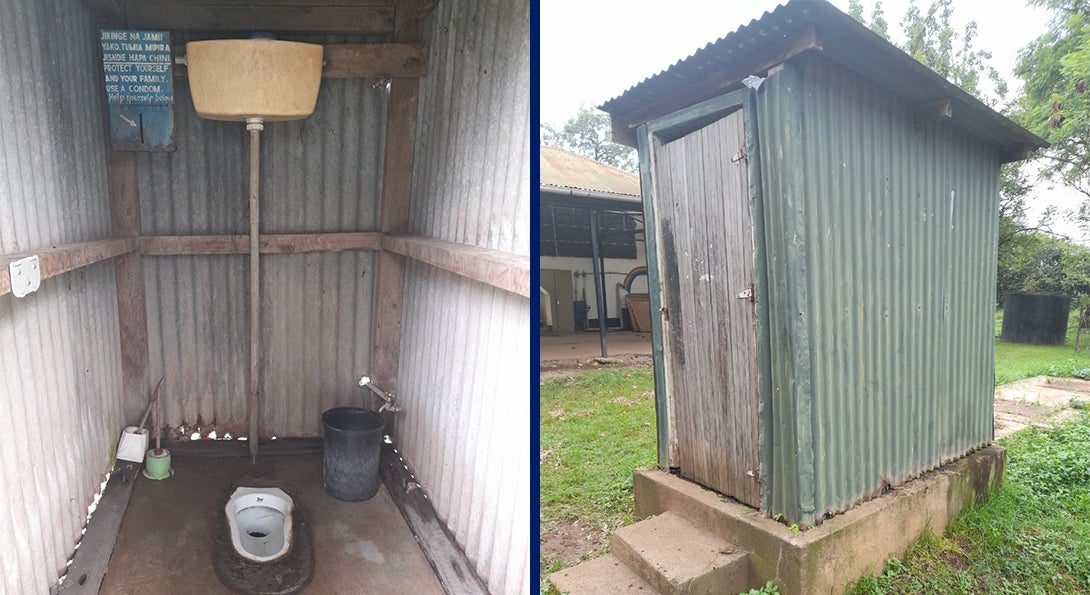Global Water Quality and Health Research
At the intersection of sanitation and clean water Heading link

People may choose fields, bushes or other open space for defecation if they do not have a toilet readily accessible. Open defecation causes diarrheal disease in children, which leads to malnutrition and increased mortality. As communities shift to ‘open defecation free (ODF)’ and construction of toilets, related diarrheal disease should decrease.
Courtney Babb, MS in Epidemiology ’15, partnered with the Ministry of Health in Nyando District, Kenya, to evaluate latrine intervention conditions in relation to diarrheal disease. Babb and community health workers visited individual households across 33 villages to take water samples for testing and assess latrine conditions. Unexpectedly, children in households without ODF zones had the same rate of diarrhea as children in ODF areas. Babb demonstrated that this was due to greater availability of safer water in the non-ODF areas compared to the ODF areas.
Shockingly, the prevalence of unsafe water by sub-location ranged from 43 percent to 87.5 percent by World Health Organization (WHO) classification of coliform bacteria and other water quality indicators. According to WHO, by 2025, half of the world’s population will be living in water-stressed areas.
Solar-powered household water treatment to improve health Heading link
Taking on this urgent need for clean water solutions, Sam Dorevitch, MD, research associate professor of environmental and occupational health sciences, initiated testing of new solar-powered technologies for greater clean water access. In partnership with the Safe Water and AIDS Project (SWAP), a non-governmental organization based in Kisumu, Kenya, Dorevitch identified very high levels of E. coli bacteria in water used by families for drinking.
With locally-led implementation by SWAP, Dorevitch’s team deployed new solar-powered methods for disinfecting drinking water. This was first done at the household level, with each home receiving a solar panel and water treatment device, developed at the University of Illinois, that produces ozone gas, a powerful oxidant that kills bacteria, viruses and parasites. With success at the household level, the project scaled up to supplying safe water at the community level, providing for 100 families per day. That scale-up was funded by the Bill and Melinda Gates Foundation.
The research demonstrated that this ozone-based approach reduced bacteria levels by more than 99.9 percent. SPH students played a key role on Dorevitch’s team, completing applied field practice experiences with SWAP and co-authoring publications with Kenyan colleagues that described this innovative research. Ongoing research addresses the economics and financing of the systems and a study of the microbiome (microbial community normally present) in the intestinal tract of children before and after drinking water treatment began.
Learn more about the project Heading link
Meet the researcher Heading link
Mitigating the impact of exposure to arsenic in water on neonatal and children's health Heading link

Arsenic is one of the most common naturally occurring contaminants found in the environment. An estimated 200 million people worldwide are exposed to arsenic concentrations in drinking water that exceed the recommended limit in WHO guidelines. The situation is perhaps the most devastating in Bangladesh, with more than 57 million people exposed to arsenic concentrations exceeding safe limits in their drinking water.
Chronic exposure in adults leads to many adverse health outcomes, including cardiometabolic, respiratory, liver, kidney and neurodevelopmental diseases, as well as cancers. There is growing evidence that arsenic exposure in utero and early childhood may profoundly influence disease later in life.
Maria Argos, PhD, associate professor of epidemiology, earned an NIH award for a five-year study of prenatal and early life arsenic exposure in a cohort of 500 mother-child dyads in Bangladesh. Early results show that prenatal arsenic exposure is associated with adverse pregnancy outcomes. Women who had experienced stillbirth were 2.5 times more likely to be exposed to elevated arsenic concentrations than those with live birth. The ongoing study, with collaboration of Bangladeshi researchers, will inform future arsenic prevention and remediation interventions targeted to pregnant women, women of child-bearing age and children.
Selected quote Heading link
We are following these children into the future to look at patterns with blood pressure, diabetes-related markers, growth and other measures.
| Associate Professor of Epidemiology

